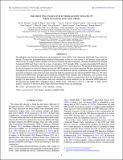THE FIRST TWO YEARS OF ELECTROMAGNETIC FOLLOW-UP WITH ADVANCED LIGO AND VIRGO
Author(s)
Singer, Leo P.; Price, Larry R.; Farr, B.; Urban, Alex L.; Pankow, Chris; Vitale, Salvatore; Veitch, John; Farr, Will M.; Hanna, C.; Cannon, K. C.; Downes, T. P.; Graff, P. B.; Haster, C.-J.; Mandel, Ilya; Sidery, Trevor; Vecchio, Alberto; ... Show more Show less
DownloadSinger-2014-THE FIRST TWO YEARS.pdf (2.811Mb)
PUBLISHER_POLICY
Publisher Policy
Article is made available in accordance with the publisher's policy and may be subject to US copyright law. Please refer to the publisher's site for terms of use.
Terms of use
Metadata
Show full item recordAbstract
We anticipate the first direct detections of gravitational waves (GWs) with Advanced LIGO and Virgo later this decade. Though this groundbreaking technical achievement will be its own reward, a still greater prize could be observations of compact binary mergers in both gravitational and electromagnetic channels simultaneously. During Advanced LIGO and Virgo's first two years of operation, 2015 through 2016, we expect the global GW detector array to improve in sensitivity and livetime and expand from two to three detectors. We model the detection rate and the sky localization accuracy for binary neutron star (BNS) mergers across this transition. We have analyzed a large, astrophysically motivated source population using real-time detection and sky localization codes and higher-latency parameter estimation codes that have been expressly built for operation in the Advanced LIGO/Virgo era. We show that for most BNS events, the rapid sky localization, available about a minute after a detection, is as accurate as the full parameter estimation. We demonstrate that Advanced Virgo will play an important role in sky localization, even though it is anticipated to come online with only one-third as much sensitivity as the Advanced LIGO detectors. We find that the median 90% confidence region shrinks from ~500 deg[superscript 2] in 2015 to ~200 deg[superscript 2] in 2016. A few distinct scenarios for the first LIGO/Virgo detections emerge from our simulations.
Date issued
2014-10Department
MIT Kavli Institute for Astrophysics and Space ResearchJournal
Astrophysical Journal
Publisher
Institute of Physics/American Astronomical Society
Citation
Singer, Leo P., Larry R. Price, Ben Farr, Alex L. Urban, Chris Pankow, Salvatore Vitale, John Veitch, et al. “THE FIRST TWO YEARS OF ELECTROMAGNETIC FOLLOW-UP WITH ADVANCED LIGO AND VIRGO.” The Astrophysical Journal 795, no. 2 (October 17, 2014): 105. © 2014 American Astronomical Society.
Version: Final published version
ISSN
1538-4357